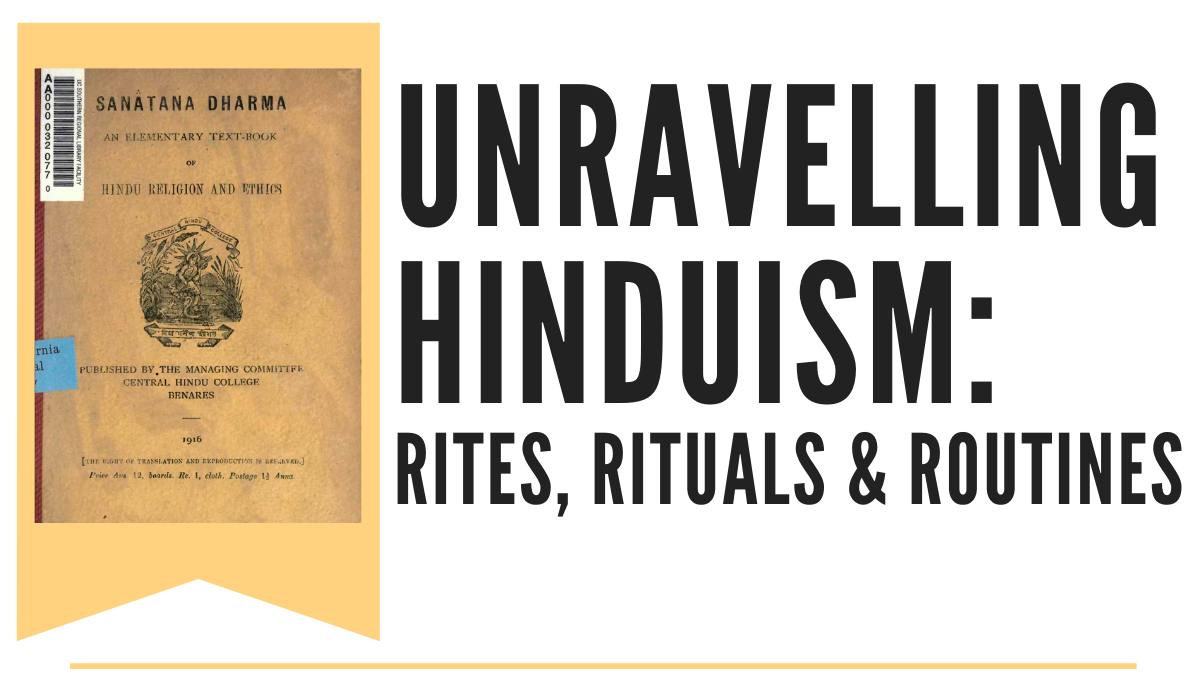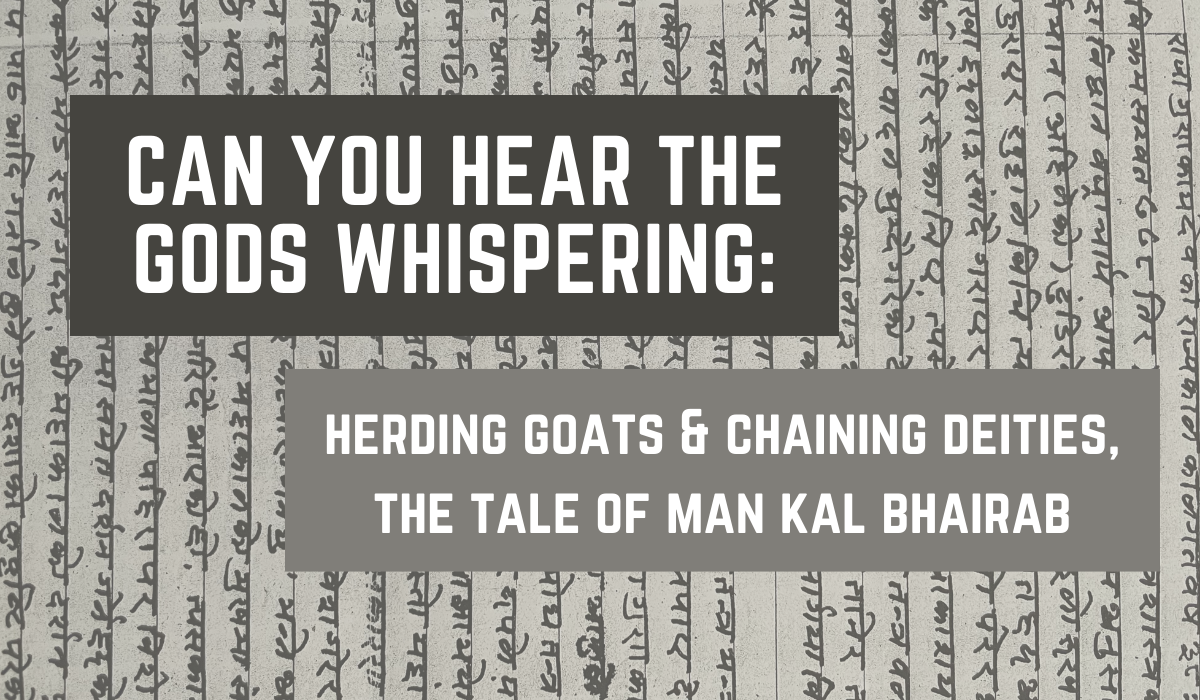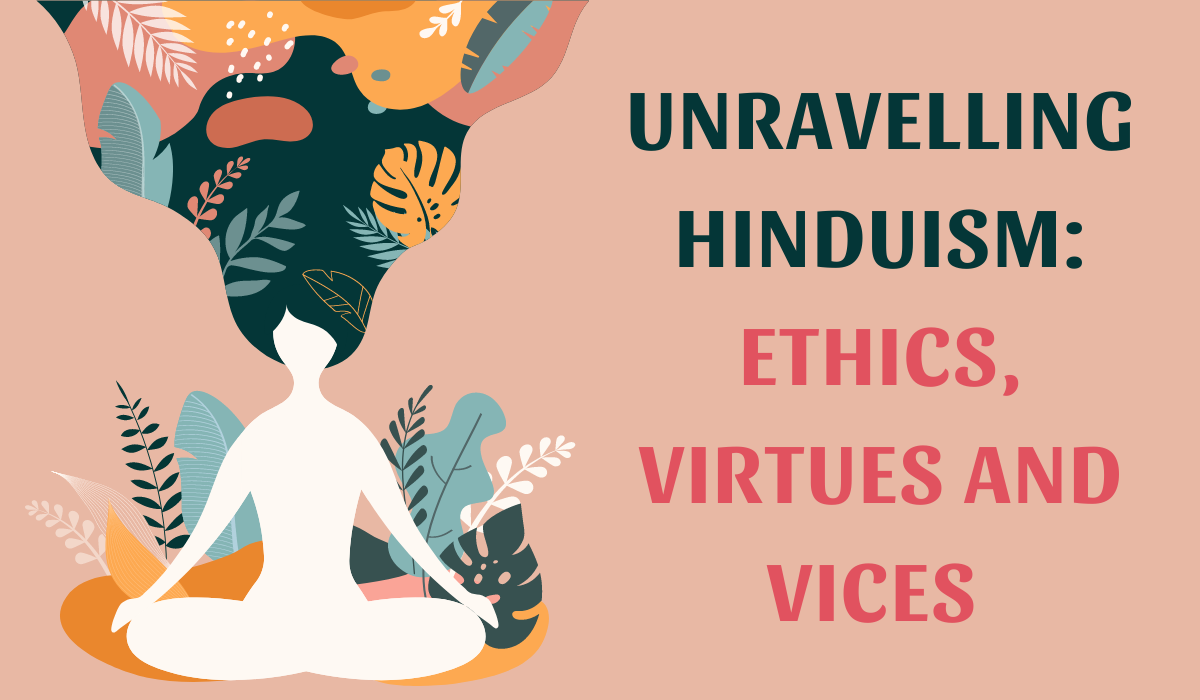Unravelling Hinduism: Rites, Rituals and Routines

I read “Sanatana Dharma: An Elementary Textbook of Hindu Religion and Ethics” so you don’t have to.
I am sure that some of us have both the time and intellect to delve into and understand the Hindu scriptures. However for most of us (myself included) this is probably more than we can handle. Therefore I found the aforementioned book (Sanatana Dharma) and read it to gain a better understanding of my religion and the rituals and practices which define life in Nepal for a lot of people. Even this textbook version of Hinduism was a challenge to understand and process, though I have tried my best to root out the key takeaways and major points of importance and plan to share them with you all.
Therefore, I will attempt to break the vast and confusing Hindu teachings down into smaller more accessible “bite sized” chunks. Here we take a simplified look at Hinduism’s rituals and religious customs such as those that govern daily life, death and man’s relationship with God.
You may find it helpful to read the first part of this series in which I break down basic Hindu principles and beliefs before reading what follows in order to better understand the terminology used. Click here to read Unravelling Hinduism: Basic Religious Principles.
Samskaras or ceremonies in Hinduism are used for three main reasons. Firstly to help the Jiva (the soul or spirit) purify itself, secondly ceremonies are used to seek help from Devas (deities) and Rishis (learned men) and thirdly ceremonies allow one to improve one’s atmosphere which allows for greater concentration and steadiness. These ceremonies are performed with help from objects, gestures, postures and sounds. Objects can include offerings such as flowers with particular offerings made to some Devas who prefer them, such as Rudrakshas for Shiva. The gestures and postures used have an effect on our Prana (that which gives us consciousness) while sounds, such as mantras, are used to regulate vibrations which help the Jive to remain steady in its devotion. Mantras are also helpful in gaining the attention of the Devas and Rishis and act to banish hostility from our environment. A mantra is a very specifically crafted sound, its vibration and is very important and is what gives it meaning. This is why mantras cannot be translated into different languages as they would lose their specific vibration and meaning. The one who utters the mantra is just as important as the mantra itself given that if someone who is not “good” utters a mantra it will do the individual harm as it is a person’s thoughts and resolve which make the mantra effective. It is also worth noting that a silently recited mantra is thought to be more effective than one that is said out loud.
There are 10 Samskaras which mark the major life events of a Hindu. Many of these are not practiced today but some that people today may recognise are as follows. The sixth Samskara is called Annaprasanam and marks the first time a baby is fed solid food. The seventh ceremony is Chudakaranam which is when a child’s ears are pierced. The eight ceremony is Upanayana which is when a boy is taught by a Guru and given a sacred thread, marking the stage of life when he becomes a student. The tenth Samskara is Vivah, which is the practice of marriage.
In addition to the Samskaras are the sixteen ceremonies known as Shraddha. These are performed by the living descendants of a deceased person in order to help their Jiva, which comes to be known as Preta once the Jiva has been cremated and has left its visible body behind. The visible body, known as the Annamayakosha (made up of solids, liquids and gases) is cremated, thus allowing the Pranamayakosha (made up of ethers which we cannot see) to disperse. If a body is not cremated the Pranamayakosha lingers causing harm to the departed Preta, the decomposing body also sends out harmful gases, meaning it is preferable for the departed as well as for those that remain to cremate the dead.
The Shraddhas performed on earth, such as the Sapindikarana, help the Jiva progress from Pretaloka (where they remain for one year) to Pitriloka which is where our departed ancestors live, this is contained within Bhuvarloka (the world between earth and heaven which is invisible to us). Once the Jiva has passed into Svaragaloka (heaven) they no longer need the help of Shraddhas.
These are the rites to be followed after death, however there are also rules for the living to follow. These are known as Shaucham, namely rules that keep the body pure in order to ensure health and vitality. These are laws of nature which affect the Annamayakosha (the visible body) and Pranamayakosha (the invisible body) and if they are not followed the body will become diseased or ill.
The rules of Shaucham will teach us to be healthy by taking in healthy particles and expelling impure ones. We are taught that everything around us is made up of atoms and when we interact with our surroundings what we are actually doing is exchanging atoms with the world around us. This interaction must be maintained in order to keep the inside and outside of our bodies clean.
To keep the inside of our bodies clean we must follow certain rules pertaining to food, water, milk and air. Food must be consumed in its freshest and purest form. Fresh leaves, fruit, grains and roots are full of life and must be eaten fresh. If these foods are stale that means their life is almost over and they are impure. Water must also be pure and is a necessary part of life, and infusions of water such as tea can be consumed in moderation. Milk is thought to be the purest source of food and drink whilst anything fermented, such as alcohol, is thought to be impure as it has entered into a stage of decomposition which can bring about illness. Pure air is also as vital as food.
To keep the outside of our bodies clean, bathing should be undertaken once a day while repeating mantras and washing should always take place before meals. Garments should also be washed regularly. Being clean both inside and out means the air and particles around you are kept clean too.
Dangers to this cleanliness and purity come from alcohol and some plants such as onion and garlic which can be harmful for the Pranamayakosha. Bad company is also a significant danger as an impure Manomayakosha (the part of the mind ruled by passions) in others can negatively impact us and is the biggest source of impurity for the Annamayakosha and Pranamayakosha. Even if one follows Shaucham strictly, if their passions are impure they are pouring out impurity.
In addition to these rules, there are also Five daily sacrifices which govern the life of a Hindu. These sacrifices teach us about the relations we have with our superiors, equals and inferiors. We must remember that none of us is an isolated unit and by practicing these sacrifices we help turn the wheel of life and help the evolution of the three worlds. Each sacrifice has an outwardly visible sacrifice which pertains to an inner meaning. The five sacrifices and their meanings are as follows:
- Sacrifice to Rishis or Vedas
- Outer sacrifice is made through study and teaching.
- Inner meaning is that we learn in order to be able to teach, so all learning is actually a sacrifice.
- Sacrifice to Devas
- Outer sacrifice is made through Homa which are offerings made to fire to repay the Devas for their guidance and to show our service.
- Inner meaning is that we realise our relation with, and the interdependence of, the three worlds.
- Sacrifice to Pitris (Ancestors)
- Outer sacrifice is made through Tarpan which is the offering of water.
- Inner meaning is that we recognise the debt we owe to our past generations.
- Sacrifice to men
- Outer sacrifice is made through acts of hospitality.
- Inner meaning is that we all have a duty of service and must help humanity.
- Sacrifice to Bhutas (creatures and lower entities)
- Outer sacrifice is made through feeding and caring for them.
- Inner meaning is that we have a duty to care for those who are not human and we must repay their services to us.
Sacrifices alone are not enough to have conscious relations with Ishvara (God), this is where worship comes in. Worship is about trying to bring oneself closer to Ishvara by appealing to different parts of him, such as Vishnu, Shiva, and any of the Devas or Avataras (Vishnu’s divine manifestations). Regardless of what form we worship him in, we are always worshiping Ishavara, we simply choose to worship him in the form that we love best.
It is interesting to note that this is thought to be the reason to suggest that quarrels between religions and religious sects are misguided, as we are all worshipping the same god, but in the form we love the most. The difference is in the names, practices and types of worshippers not due to a difference in God.
In Hinduism, Puja is the most simple form of worship. This is when an image or picture is the focus of worship. Mantras are chanted, flowers are offered and water is poured in order to express devotion and worship. Upasana are other forms of worship, such as meditation.
Overall, Hinduism is about the order and balance imposed by Ishvara. For example the stages of human life are determined by Ishvara, which is why we go through infancy, childhood, youth, maturity and old age. The Jiva within us progresses through these stages, but the Manah (the mind) grasps at other stages, seen in examples of youths who want to grow up and old men who long for their youth, this grasping leads to a lack of serenity in life. In order to counteract this, Rishis marked out the stages in life for the Jiva. These are followed in between death and birth and are known as The Four Ashramas, meaning four resting places. These four resting places and their meanings are as follows:
- Brahmacharya. This is the student stage which begins at the Upanayana and is about learning and building good habits such as industry, obedience, humility and service. Students must be celibate in thought and act.
- Garhasthya. This stage is about being a house holder and is entered into with marriage. It is about supporting others such as one’s family through selflessness, compassion, tenderness, temperance, purity, helpfulness, good judgement and charity.
- Vanaprastha. In the past this was known as the forest dwelling or secluded stage. In modern life this can be interpreted as when householders retire from worldly labour and live a more quiet life.
- Sannyasa. In the past this stage was about living in total renunciation as an ascetic, though in modern day we can interpret this as suggesting that an old man should pass his last days in worship and meditation.
Whilst in each of these stages a man must not think about the other stages as each stage has its own rules and pleasures to be enjoyed at that stage only in order to ensure an orderly progression of the Jiva through these stages. In modern times one cannot exactly live out these Ashramas but the fundamental duties of each can still be observed.
Lastly, Hindu customs cover the issue of The Four Castes. While caste divisions defined Hindu societies of the past, it is our belief that these older notions of division should be left behind. The Aviskara team in no way supports, condones or believes in caste divisions or in caste based discrimination. Therefore in an attempt to stop the proliferation of caste based ideals we have chosen to omit any teachings which we believe to be casteist. As modern Hindus, casteism is something we have to grapple with as a remnant of a much older system of social division and we must do our very best to leave these divisive systems behind while still respecting different ethnic backgrounds and practices. The information that follows is intended as a purely informational retelling of ancient Hindu ideas and is not meant to cause offence or to suggest that this is how we ought to live today and in the future.
In simple terms, Hinduism teaches that the Jiva goes through universal stages called Varnas, which humans eventually developed into social classes or castes. The first stage is when the Jiva is in its infancy, the second stage is the early adulthood of a Jiva, the third stage is the latter adulthood of a Jiva and the fourth is the serene old age of the Jiva.
Read the first and third instalments of this series here:


